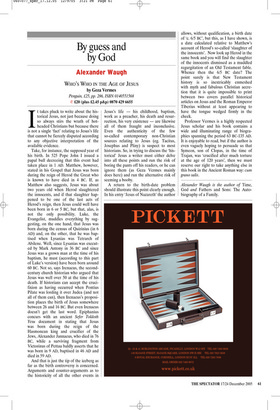By guess and by God
Alexander Waugh
WHO’S WHO IN THE AGE OF JESUS by Geza Vermes Penguin, £25, pp. 286, ISBN 0140551568 ✆ £20 (plus £2.45 p&p) 0870 429 6655 It takes pluck to write about the historical Jesus, not just because doing so always stirs the wrath of hotheaded Christians but because there is not a single ‘fact’ relating to Jesus’s life that cannot be fiercely disputed according to any objective interpretation of the available evidence.
Take, for instance, the supposed year of his birth. In 525 Pope John I issued a papal bull decreeing that this event had taken place in 1 AD. Matthew, however, stated in his Gospel that Jesus was born during the reign of Herod the Great who is known to have died in 4 BC. If, as Matthew also suggests, Jesus was about two years old when Herod slaughtered the innocents, and if that slaughter happened to be one of the last acts of Herod’s reign, then Jesus could well have been born in 6 or 5 BC, but that, alas, is not the only possibility. Luke, the Evangelist, muddles everything by suggesting, on the one hand, that Jesus was born during the census of Quirinius (in 6 AD) and, on the other, that he was baptised when Lysanias was Tetrarch of Abilene. Well, since Lysanias was executed by Mark Antony in 36 BC and since Jesus was a grown man at the time of his baptism, he must (according to this part of Luke’s version) have been born around 60 BC. Not so, says Irenaeus, the secondcentury church historian who argued that Jesus was well over 50 at the time of his death. If historians can accept the crucifixion as having occurred when Pontius Pilate was lording it over Judea (and not all of them can), then Irenaeus’s proposition places the birth of Jesus somewhere between 26 and 16 BC. But even Irenaeus doesn’t get the last word. Epiphanius concurs with an ancient Sefer Toldoth Yesu document in stating that Jesus was born during the reign of the Hasmonean king and crucifier of the Jews, Alexander Jannaeus, who died in 76 BC, while a surviving fragment from Victorinus of Pettau baldly asserts that he was born in 9 AD, baptised in 46 AD and died in 59 AD.
And that is just the tip of the iceberg as far as the birth controversy is concerned. Arguments and counter-arguments as to the historicity of all the other events in Jesus’s life — his childhood, baptism, work as a preacher, his death and resurrection, his very existence — are likewise all of them fraught and inconclusive. Even the authenticity of the few so-called contemporary non-Christian sources relating to Jesus (eg. Tacitus, Josephus and Pliny) is suspect to most historians. So, in trying to discuss the ‘historical’ Jesus a writer must either delve into all these points and run the risk of boring the pants off his readers, or he can ignore them (as Geza Vermes mainly does here) and run the alternative risk of seeming a booby.
A return to the birth-date problem should illustrate this point clearly enough. In his entry ‘Jesus of Nazareth’ the author allows, without qualification, a birth date of ‘c. 6/5 BC’, but this, as I have shown, is a date calculated relative to Matthew’s account of Herod’s so-called ‘slaughter of the innocents’. Now look up Herod in the same book and you will find the slaughter of the innocents dismissed as a muddled regurgitation of an Old Testament fable. Whence then the 6/5 BC date? The point surely is that New Testament history is so inextricably enmeshed with myth and fabulous Christian accretion that it is quite impossible to print between two covers parallel historical articles on Jesus and the Roman Emperor Tiberius without at least appearing to have the tongue wedged firmly in the cheek.
Professor Vermes is a highly respected Jesus scholar and his book contains a wide and illuminating range of biographies spanning the period 63 BC-135 AD. It is enjoyable to read, but if the author is even vaguely hoping to persuade us that Symeon, son of Clopas, in the time of Trajan, was ‘crucified after much torture at the age of 120 years’, then we must reserve our right to take anything else in this book in the Ancient Roman way: cum grano salis.


















































































 Previous page
Previous page